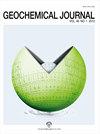日本中部太平洋沿岸静冈平原古海啸沉积地球化学特征
IF 1.6
4区 地球科学
Q3 GEOCHEMISTRY & GEOPHYSICS
引用次数: 2
摘要
日本地球化学学会版权所有©2021。(Mw)以前已经利用地质记录估计了过去地震的强度(Minoura et al., 1994;Nanayama et al., 2003;Goto et al., 2014;chagu本文章由计算机程序翻译,如有差异,请以英文原文为准。
Geochemical characteristics of paleotsunami deposits from the Shizuoka plain on the Pacific coast of middle Japan
Copyright © 2021 by The Geochemical Society of Japan. (Mw) of past earthquakes have been previously estimated using geological records (Minoura et al., 1994; Nanayama et al., 2003; Goto et al., 2014; Chagué-Goff et al., 2015; Sawai et al., 2009, 2012, 2015). An event deposit is preliminarily found using grain size changes in a geologic stratum along with multiple other proxies for environmental changes (Watanabe et al., 2020). Additionally, geochemical analysis is widely used to estimate the source of the sediments (Minoura and Nakaya, 1991; Chagué-Goff et al., 2017). Following recent major subduction zone earthquakes, the analysis of tsunami deposits has been increasing to help clarify such geochemical features (Chagué-Goff et al., 2017; Watanabe et al., 2020). The geochemical signatures of tsunami deposits from the southwestern coasts of Spain, New Zealand, the Hawaiian Islands, Mexico and northeastern Japan have also been studied (Minoura et al., 1994; ChaguéGoff, 2010; Roy et al., 2012; Kuwatani et al., 2014; Yamasaki et al., 2015; Goff et al., 2020). Recently, geochemical characteristics of tsunami deposits have been well documented on the Pacific coast in the Tohoku Geochemical characteristics of paleotsunami deposits from the Shizuoka plain on the Pacific coast of middle Japan
求助全文
通过发布文献求助,成功后即可免费获取论文全文。
去求助
来源期刊

Geochemical Journal
地学-地球化学与地球物理
CiteScore
1.70
自引率
12.50%
发文量
11
审稿时长
6 months
期刊介绍:
Geochemical Journal is an international journal devoted to original research papers in geochemistry and cosmochemistry. It is the primary journal of the Geochemical Society of Japan. Areas of research are as follows:
Cosmochemistry; Mineral and Rock Chemistry; Volcanology and Hydrothermal Chemistry; Isotope Geochemistry and Geochronology; Atmospheric Chemistry; Hydro- and Marine Chemistry; Organic Geochemistry; Environmental Chemistry.
 求助内容:
求助内容: 应助结果提醒方式:
应助结果提醒方式:


